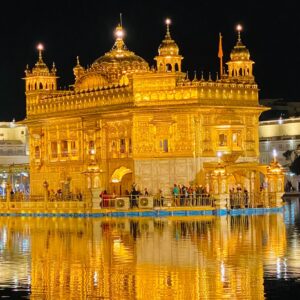Description
Ayodhya, located on the banks of the Sarayu River in Uttar Pradesh, is a city steeped in mythology, history, and spirituality. It is revered as the birthplace of Lord Rama and holds great significance in Hinduism.
Key Attractions in Ayodhya
Here are some key tourist spots to explore in Ayodhya:
- Ram Janmabhoomi Mandir: Ram Janmabhoomi Mandir is the birthplace of Lord Rama and is one of the holiest sites in Ayodhya. Visitors can explore the Ram Janmabhoomi Mandir. It includes the sacred of Lord Rama’s birth. Various shrines and temples dedicated to Lord Rama and other deities also form a part of the Temple.
- Hanuman Garhi: Hanuman Garhi is a prominent temple dedicated to Lord Hanuman, the devoted disciple of Lord Rama. Situated atop a hill, the temple offers panoramic views of Ayodhya and the surrounding area. Visitors can climb the 76 steps to reach the temple and seek blessings from Lord Hanuman.
- Kanak Bhawan: Kanak Bhawan is a beautifully adorned temple dedicated to Lord Rama and Goddess Sita. It is believed to have been gifted to Goddess Sita by King Dasharatha, Rama’s father, as her wedding gift. The temple is known for its exquisite architecture and intricate carvings.
- Nageshwarnath Temple: Dedicated to Lord Shiva, the Nageshwarnath Temple is one of the oldest temples in Ayodhya. It is believed to have been established by Kush, the son of Lord Rama. The temple is known for its serene ambience and spiritual significance.
- Treta Ke Thakur: Treta Ke Thakur is a temple dedicated to Lord Rama. It is believed that Lord Rama performed the Ashwamedha Yagna at this temple. The temple complex also includes shrines dedicated to other deities, making it a sacred pilgrimage site for devotees.
- Guptar Ghat: Guptar Ghat is a serene bathing ghat on the banks of the Sarayu River. Devotees also come to take holy dips and perform rituals on this ghat. It is believed to be the spot where Lord Rama took his final bath before leaving the earth.
Ayodhya & Ram Janmabhumi Tour Package
3 – 5 Days
How to Reach?
- By Air: Maharishi Valmiki International Airport Ayodhya Dham 10 km away from the City.
- By Road: Ayodhya is well-connected to major cities and towns in India by road. Here’s how to reach Ayodhya by road:
- From Lucknow: Ayodhya is approximately 135 kilometres from Lucknow, the capital of Uttar Pradesh. The journey takes around 3-4 hours by road via NH27.
- From Varanasi: Ayodhya is about 200 kilometres from Varanasi. The journey takes approximately 5-6 hours by road via NH31 and NH31A.
- From Delhi: Ayodhya is approximately 700 kilometres from Delhi. The journey takes around 12-13 hours by road via NH19 and NH44.
You can hire taxis, and cabs, or use intercity bus services to reach Ayodhya from these cities. The roads are generally well-maintained, offering a smooth travel experience.
- By Rail: Ayodhya has a railway station known as Ayodhya Junction (AY). Travelers can check the train schedules and book tickets via the Indian Railways website or at railway reservation counters.
Day 1: Arrival and Spiritual Exploration
- Start your day with a visit to the Ram Janmabhoomi Temple, offering prayers and exploring the sacred surroundings.
- Visit Hanuman Garhi, climbing the stairs to seek blessings and enjoy the scenic views of Ayodhya.
- Have lunch at a local eatery, savouring traditional vegetarian cuisine.
- Explore Kanak Bhawan, admiring the frescoes depicting scenes from the Ramayana.
- In the evening, visit Swarg Dwar and witness the serene atmosphere at this sacred site.
- Attend the evening aarti (prayer ceremony) at any of the temples.
Day 2: Historical and Cultural Exploration
- Begin your day with a visit to Nageshwarnath Temple, one of the oldest temples in Ayodhya. Explore the temple complex and pay homage to Lord Shiva.
- Have breakfast at a nearby café or restaurant.
- Visit Treta Ke Thakur, the temple dedicated to Lord Rama, and learn about its historical significance.
- Take a guided tour of Ayodhya, exploring its historical and cultural landmarks, including ancient ruins and heritage sites.
- Enjoy lunch at a local eatery, sampling traditional Ayodhya delicacies.
- In the evening, explore the local markets and shops, picking up souvenirs and handicrafts.
- Attend the evening aarti ceremony at Ram Janmabhoomi or Hanuman Garhi, experiencing the spiritual fervour of Ayodhya.
Ideal Time to Visit
The ideal time to visit Ayodhya is during the winter from October to February. The weather is pleasant and suitable for sightseeing and outdoor activities during this time. This time coincides with various festivals and religious events, such as Diwali and Ram Navami. Ayodhya is adorned with lights and decorations, for these festivals creating a jubilant atmosphere.
Avoid visiting during the summer months (March to June) when temperatures can soar, making outdoor activities uncomfortable. Additionally, plan your visit during weekdays to avoid the crowds that often flock to Ayodhya on weekends.









Reviews
There are no reviews yet.